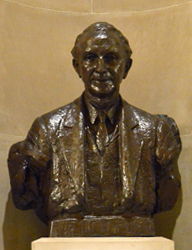
Indiana Governor from 1941-1944; 1949-1952
- Lieutenant Governor, 1937-1940
- Delivered nomination speech for Illinois Governor Adlai Stevenson at the Democratic National Convention, 1952
Bust Location
Statehouse Rotunda
3rd floor, Facing east,
south corner
Born
North Judson (Starke County)
Lived
Knox
Henry Frederick Schricker was born on August 30, 1883 in North Judson, Indiana to Bavarian immigrants. Schricker attended public school in Starke County until graduating from eighth grade in 1897.68 After this schooling, Schricker worked in his family’s grocery and mercantile store, while completing a series of bookkeeping courses at a business college in South Bend. In 1905, Schricker decided to read for the law under local attorneys, serving as the clerk of the Starke County Circuit Court. At that time, Individuals did not go to law school. Instead, they studied, or “read,” under a lawyer already accepted to the bar. After one year of reading the law, Schricker was accepted to the Indiana state bar in 1906.69
For two years, Schricker worked as a cashier of a small bank in Hamlet, Indiana. In 1908, Henry Schricker purchased the Starke County Democrat, a weekly newspaper published in Knox. He ran this paper for 11 years. While he was running the newspaper, Schricker married Maude L. Brown, and they had a daughter and two sons. In 1919, Schricker sold the Starke County Democrat, returning to the bank business as a cashier of the Farmers Bank and Trust in Knox.70
Henry Schricker’s political career began with an unsuccessful campaign to become a state senator from Starke county in 1924, but he was able to get the seat he desired eight years later. In 1932, the political tides had turned in favor of the Democratic Party and Schricker was one of 25 Democratic senators to join the Indiana General Assembly. In 1935, Henry Schricker was nominated by his party to serve as caucus chairman. In 1936, Schricker was elected to a second term in the state senate, but instead chose to serve as Lieutenant Governor under M. Clifford Townsend.71
During his four years as Lieutenant Governor, Henry Schricker avoided political controversy, which was a key factor in his receiving the Democratic nomination for Indiana governor in 1940. Owing in large part to his duties as lieutenant governor, he served as Indiana’s agricultural commissioner Schricker was very popular among rural communities, and it was these populations which helped him to win the gubernatorial election. At the same time, the Republican Party gained control of both houses of the Indiana General Assembly, placing Schricker in a difficult position entering his first term as Governor.72
The issue which gained the most attention throughout Schricker’s first term had first come into the public eye in 1933, when the Executive Reorganization Act was pushed through by then Governor Paul V. McNutt. Schricker had been in the Indiana Senate at the time, and hesitatingly voted in the act along with the Democratic majority. The act centralized administrative control in the hands of the Governor as the head executive of the state.73 In 1940, with the Republican Party in the majority, they not only planned to repeal the act, but to take much more power away from the Governor.74
Henry Schricker was adamantly opposed to these new laws from the beginning, but the Executive Reorganization Act was repealed and the State Administration Act of 1941 was passed. This act created a number of laws which seriously crippled gubernatorial power. After an unsuccessful attempt to veto these new laws, Schricker filed for an injunction in Marion County Circuit Court. The decision of this court was appealed by Secretary of State James M. Tucker and other Republican officials, and the Supreme Court voided the Republican Party’s plan, asserting that the Governor is the state's chief executive.75 This issue defined Schricker’s first term.
At the time that Henry Schricker served as Governor, the constitution stated that no individual could serve in the position for more than four out of eight years, so Schricker was not eligible to run for re-election. Instead, he received his party’s nomination for the U.S. Senate seat, of which he did not win. Instead, Schricker returned to the banking business until he was called on to run as the Democratic candidate for governor again in 1947. With his reelection in 1948, Schricker became the first person to serve as Governor for two terms. At the time of his election, both houses of the Indiana General Assembly were once again in Republican control.76
The last big event in Henry Schricker’s political career occurred during the 1952 presidential election, when Schricker delivered the nomination speech of Illinois Governor Adlai Stevenson at the Democratic National Convention in Chicago. In that same year, Schricker ran for the U.S. Senate seat again, and was once again defeated.77 With the end of his second term as Indiana Governor in January 1953, Schricker left public office for the final time.78 When he retired, Schricker returned to Knox, Indiana, where he died on December 28, 1966. He is buried at Crown Hill Cemetery in Knox.79
Bust History
The bust was dedicated on November 11, 1964 in a ceremony that drew over 350 people. Former Governor Schricker attended with his wife and their six grandchildren. The bust was unveiled before the reading of a message from then president, Lyndon B. Johnson. The Schricker bust displaced a bust of Abraham Lincoln, which is now located in a niche on the northeast corner on the outside of the rotunda on the second floor of the Statehouse. The bust cost $3,500 dollars and was paid for by the governor's contingency fund. Sculptor Rubins placed the bust of Governor Schricker on a rock in order "to establish the deep strength of the man."80
Sculptor
David Kresz Rubins
David Kresz Rubins was born in Minneapolis in 1902. As a young man, he apprenticed to J.E. Fraser before moving on to study at Dartmouth College and the Beaux-Arts Institute of Design in New York. He then traveled to Europe to study in Paris, where he was awarded the Paris Prize in Sculpture. He was a fellow of the American Academy in Rome 1928 to 1931. He joined the faculty of the Herron School of Art in Indianapolis in 1935. While there, he taught drawing, anatomy, ceramics, and sculpture. He also authored a textbook, "The Human Figure: An Anatomy for Artists", in 1953. Rubins retired from teaching in 1970, three years after Herron became a part of Indiana University. He was named professor emeritus in 1981. He died in 1985 at the age of 82. Rubins’ work includes the statue of Young Abraham (located between the North and South Government Center buildings in Indianapolis, just outside of the Indiana Statehouse), along with a number of plaques at Riley Hospital.81
